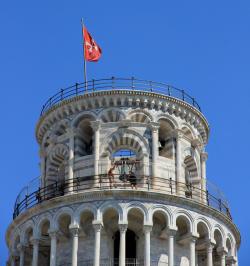Integrity, authenticity, protection, and management of the site

The characteristics of integrity, authenticity, protection, and management of the Site
In addition to compliance with one or more selection criteria, there are other necessary conditions for the heritage (or Site) to be recognized as having Outstanding Universal Value: the fulfillment of the conditions of integrity and authenticity and the implementation of an adequate protection and management system to ensure its protection.
- INTEGRITY
The Piazza del Duomo, as seen today, is a monumental complex inscribed within a public space and represents the result of a long and articulated artistic and architectural project started in 1063, with the establishment of the new Cathedral, and which ended in the fourteenth century with the completion of the entire square. The Site, registered in the WHL, includes 8.87 hectares, surrounded by a buffer area of 254 hectares, serving to protect and preserve the assets, as well as their Outstanding Universal Value that guaranteed its world heritage status in 1987. The interventions carried out over the centuries, after the completion of the square, have retained the integrity of the structures and the spatial relationship between the monuments. The link between the monuments and their historical context has also been protected and is still visible today. Likewise, the expansion of the Site ensured that the three main visual axes were adequately respected. The creation of the buffer zone also provided an additional level of protection for the Site's attributes – although the need for additional of protection was identified in the area located to the north and west of the Site.
- AUTHENTICITY
The monumental complex of Piazza del Duomo in Pisa has preserved over time the historical-artistic characteristics and attributes that convey its Outstanding Universal Value. After the construction of the monumental buildings and the square, the numerous architectural and urban interventions that have taken place have strengthened the relationship between the Square itself and the City, respecting the values and significance of the buildings of the monumental complex. In more recent times, all the restoration works have been carried out by qualified personnel, according to international and national standards. The authenticity of the Site, in particular in terms of conformity, location, architectural techniques and historical-artistic value has, therefore, been preserved over time.
- PROTECTION AND MANAGEMENT
There is an adequate legislative and protective framework at the national level, which is reflected in the municipal plans. Thanks to these tools, the structure and the historical-artistic value of the monuments must be protected and preserved over time. In this regard, it should be remembered that the monuments that are part of Piazza del Duomo are all subject to constraints, according to which any work to be carried out on the site requires the approval of the Ministry of Cultural Heritage and Activities and Tourism through the its local offices. As regards the intended use, the sites of architectural interest are classified as "urban structures" and in particular the Monumental Cemetery is considered a real museum. The lawn areas are classified as "gardens of historical, architectural or natural value".
To the protection guaranteed by the instruments of legislative protection is added that guaranteed by a stable management structure, which oversees the monuments in the Square under the responsibility of the Opera della Primaziale Pisana (OPA).The Opera della Primaziale Pisana is the body responsible for managing the Site and the monuments it houses. The OPA has an ancient history: it was created to supervise the construction work of the monumental complex as early as the first half of the year 1000. However, it was over a century later, in 1202, that “the Worker”, or the administrator of the ‘Opera del Duomo, was appointed by the podestà and no longer by the archbishop as was the case in the past. This event guaranteed the entity its own institutional identity which remained unchanged over the centuries.
